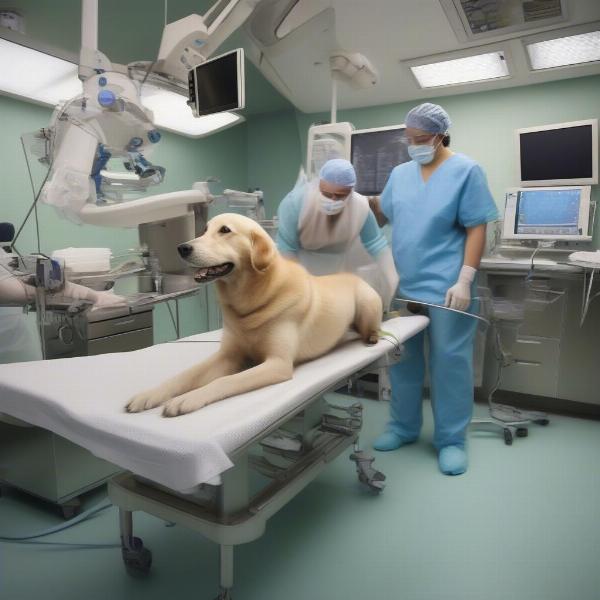Understanding the financial implications of dog leg amputation is crucial for pet owners facing this difficult decision. This article provides a detailed overview of the factors influencing amputation cost, potential additional expenses, and ways to manage the financial burden. We’ll also discuss the recovery process and long-term care for your dog after amputation.
Factors Affecting Dog Leg Amputation Cost
Several factors contribute to the overall cost of canine leg amputation. These include the complexity of the surgery, the dog’s size and health condition, geographic location, and the veterinarian’s fees. Understanding these variables can help you anticipate and prepare for the expenses involved.
Complexity of the Surgery
A simple amputation, where the affected limb is removed below the knee or elbow, is typically less expensive than a more complex procedure involving the hip or shoulder joint. The type of amputation required depends on the underlying cause, such as trauma, cancer, or a severe infection.
Dog’s Size and Health
Larger dogs require more anesthesia and medication, which can increase the overall cost. Pre-existing health conditions may also necessitate additional tests and monitoring before, during, and after the surgery, adding to the expense.
Geographic Location
Veterinary costs can vary significantly based on location. Major metropolitan areas or regions with a higher cost of living generally have higher veterinary fees.
Veterinarian’s Fees
Different veterinary clinics have different fee structures. It’s essential to obtain quotes from multiple veterinarians to compare prices and services.
 Dog Undergoing Leg Amputation Surgery
Dog Undergoing Leg Amputation Surgery
Additional Expenses to Consider
Besides the surgery itself, there are other potential expenses to consider, including pre-operative tests, pain medication, post-operative care, physical therapy, and prosthetics (if desired).
Pre-operative Tests
Blood work, X-rays, and other diagnostic tests may be necessary to assess your dog’s overall health and determine the best course of action.
Pain Management and Medication
Post-operative pain management is crucial for your dog’s comfort and recovery. This typically involves pain medication and potentially other medications to prevent infection or manage complications.
Post-operative Care
Regular check-ups and bandage changes are essential during the recovery period. These follow-up visits contribute to the overall cost.
Physical Therapy
Physical therapy can help your dog regain mobility and strength after amputation. This may involve exercises, hydrotherapy, or other rehabilitation techniques.
Managing the Financial Burden
Facing a significant veterinary expense can be overwhelming. Explore options like pet insurance, payment plans with your veterinarian, or crowdfunding platforms to help manage the financial burden.
Pet Insurance
If your dog has pet insurance, check your policy to see if amputation is covered.
Payment Plans
Many veterinary clinics offer payment plans to help spread the cost over time.
Crowdfunding
Online crowdfunding platforms can be a valuable resource for raising funds to cover veterinary expenses.
Recovery and Long-Term Care
After amputation, your dog will need time to heal and adjust. Provide a comfortable and safe environment, follow your veterinarian’s instructions carefully, and be patient throughout the recovery process. Most dogs adapt remarkably well to life with three legs.
Adapting to Life with Three Legs
With proper care and support, most dogs can lead happy and fulfilling lives after leg amputation. They learn to compensate for the missing limb and can often run, play, and enjoy activities similar to their four-legged counterparts.
Conclusion
Dog leg amputation is a significant decision with both emotional and financial implications. Understanding the factors influencing cost, preparing for additional expenses, and exploring options to manage the financial burden can help you navigate this challenging time. With proper care and support, your dog can thrive and enjoy a high quality of life after amputation. Remember to consult with your veterinarian for personalized advice and guidance tailored to your dog’s specific needs.
FAQ
- How long does it take for a dog to recover from leg amputation? The recovery period typically ranges from several weeks to a few months, depending on the individual dog and the complexity of the surgery.
- Is amputation painful for dogs? Veterinarians use pain medication and anesthesia to minimize discomfort during and after the surgery.
- Can a dog live a normal life with three legs? Yes, most dogs adapt incredibly well to life with three legs and can enjoy a happy and active lifestyle.
- What are the alternatives to amputation? Alternatives depend on the underlying cause but may include limb-sparing surgery, radiation therapy, or chemotherapy.
- How much does a dog leg prosthetic cost? The cost of a prosthetic can vary significantly depending on the size of the dog and the complexity of the device.
- Does pet insurance cover amputation? Coverage varies depending on the specific policy. It’s essential to check with your insurance provider.
- Are there financial assistance programs for pet owners facing high veterinary costs? Yes, several organizations offer financial aid for veterinary care. Research options available in your area.
ILM Dog is your trusted source for expert advice on dog breeds, health and medical care, training, nutrition, grooming, and much more. We’re dedicated to providing dog owners worldwide with practical, reliable information to help them provide the best possible care for their furry companions. For more insightful resources and expert tips, explore our website at ILM Dog. Contact us at [email protected] or +44 20-3965-8624 for personalized advice.